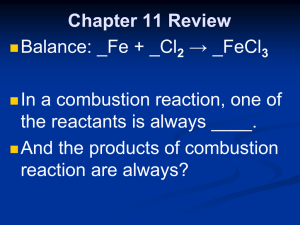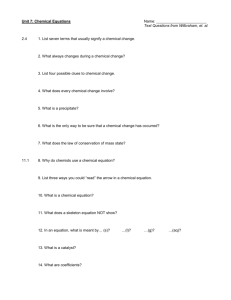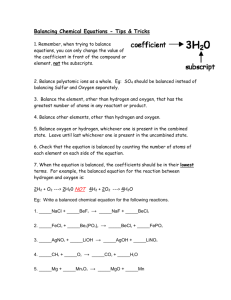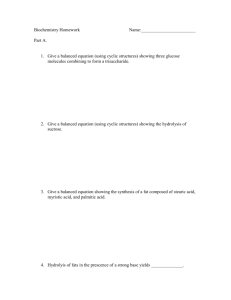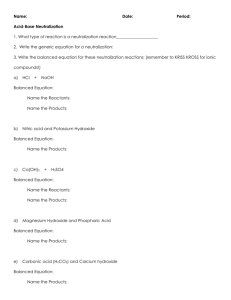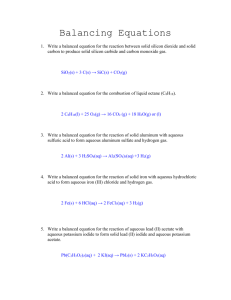Name Date Class DESCRIBING CHEMICAL REACTIONS Section
advertisement
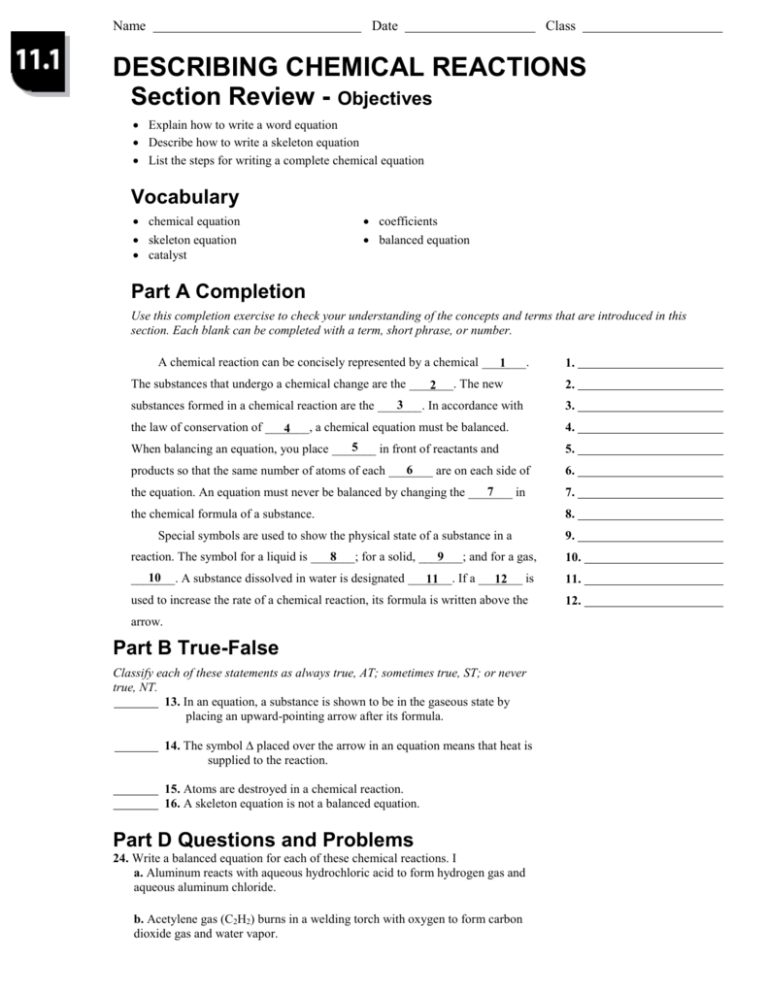
Name Date Class DESCRIBING CHEMICAL REACTIONS Section Review - Objectives Explain how to write a word equation Describe how to write a skeleton equation List the steps for writing a complete chemical equation Vocabulary chemical equation skeleton equation catalyst coefficients balanced equation Part A Completion Use this completion exercise to check your understanding of the concepts and terms that are introduced in this section. Each blank can be completed with a term, short phrase, or number. A chemical reaction can be concisely represented by a chemical _______. 1 1. The substances that undergo a chemical change are the _______. The new 2 2. 3 substances formed in a chemical reaction are the _______. In accordance with 3. the law of conservation of _______, a chemical equation must be balanced. 4 4. 5 When balancing an equation, you place _______ in front of reactants and 5. 6 products so that the same number of atoms of each _______ are on each side of 6. 7 the equation. An equation must never be balanced by changing the _______ in 7. the chemical formula of a substance. 8. Special symbols are used to show the physical state of a substance in a 9. 8 9 reaction. The symbol for a liquid is _______; for a solid, _______; and for a gas, 10. 10 _______. A substance dissolved in water is designated _______. If a _______ 11 12 is 11. used to increase the rate of a chemical reaction, its formula is written above the 12. arrow. Part B True-False Classify each of these statements as always true, AT; sometimes true, ST; or never true, NT. 13. In an equation, a substance is shown to be in the gaseous state by placing an upward-pointing arrow after its formula. 14. The symbol placed over the arrow in an equation means that heat is supplied to the reaction. 15. Atoms are destroyed in a chemical reaction. 16. A skeleton equation is not a balanced equation. Part D Questions and Problems 24. Write a balanced equation for each of these chemical reactions. I a. Aluminum reacts with aqueous hydrochloric acid to form hydrogen gas and aqueous aluminum chloride. b. Acetylene gas (C2H2) burns in a welding torch with oxygen to form carbon dioxide gas and water vapor. Part C Matching Match each description in Column B to the correct term in Column A. Column A Column B 17. chemical equation 18. skeleton equation a. an equation in which each side has the same number of atoms of each element b. a substance that speeds up the rate of a reaction c. a symbolic way of describing a chemical reaction d. substances that undergo chemical change e. a chemical equation that does not indicate the amounts of substances involved 19. catalyst 20. coefficients 21. balanced equation 22. reactants 23. products f. new substances formed in a chemical reaction g. numbers used to balance a chemical equation TYPES OF CHEMICAL REACTIONS Section Review Objectives Describe the five general types of reactions Predict the products of the five general types of reactions Vocabulary combination reaction activity series decomposition reaction single-replacement reaction double-replacement reaction combustion reaction Part A Completion Use this completion exercise to check your understanding of the concepts and terms that are introduced in this section. Each blank can be completed with a term, short phrase, or number. It is possible to _______ 1 the products of some chemical 1. reactions. In order to do this, you must be able to recognize at least 2. 2 five general types of reactions. For example, in a _______ 3. reaction, the reactants are two or more _______ and/or compounds 3 4. and there is always a _______ product. In a _______ reaction, a 4 5 5. single compound is broken down into two or more simpler 6. substances. 7. In a _______ reaction, the reactants and products are an 6 8. element and a compound. The _______ can be used to predict 7 9. whether most single-replacement reactions will take place. A 10. _______ 8 reaction involves the exchange of ions between two 11. compounds. This reaction generally takes place between two ionic 12. 9 compounds in _______ solution. One of the reactants in a 10 combustion reaction is _______. The products of the complete combustion of a hydrocarbon are _______ 11 and _______. 12 Part B True-False Classify each of these statements as always true, AT; sometimes true, ST; or never true, NT. 13. In a decomposition reaction, there is a single reactant. 14. The activity series of metals can be used to predict products in double replacement reactions. 15. Carbon dioxide and water are the products of the combustion of hexane (C 6H14). 16. A nonmetal can replace another nonmetal from a compound in a single-replacement reaction. 17. One of the products of a double-replacement reaction is a gas that bubbles out of the mixture. Part C Matching Match each description in Column B to the correct term in Column A. Column A Column B 18. combination reaction 19. decomposition reaction 20. single-replacement reaction 21. combustion reaction a. reaction in which atoms of one element replace atoms of a second element in a compound b. a reaction in which two or more substances combine to form a single substance c. reaction of a compound with oxygen to produce energy d. reaction in which a single compound is broken down into two or more products Part D Questions and Problems Answer the following in the space provided. 22. Identify the type of each of the following reactions. a. 2C6H14(l) 19O2(g) 12CO2(g) 14H2O(g) b. 2Fe(s) 3Br2(l) 2FeBr3(s) 23. Complete and balance the following equation. What must be true of one of the products? Li3PO4 Zn(NO3)2 CHEMICAL REACTIONS Practice Problems In your notebook, solve the following problems. Use the 3-step problem-solving approach you learned in Chapter 1. SECTION 11.1 DESCRIBING CHEMICAL REACTIONS 1. Write a balanced equation for the reaction between hydrogen and oxygen that produces water. 2. Write the balanced equation for the reaction that produces iron(II) sulfide from iron and sulfur. 3. Write the balanced equation representing the heating of magnesium carbonate to produce solid magnesium oxide and carbon dioxide gas. 4. Write a balanced equation for the production of HCl gas from its elements. Remember diatomic molecules! 7. Write a balanced equation representing the formation of aqueous sulfuric acid (H2SO4) from water and sulfur trioxide gas. 8. Write a balanced equation from this word equation. aqueous silver nitrate + copper metal silver metal + aqueous copper nitrate 9. Write a balanced equation for the following word equation. phosphorus + oxygen tetraphosphorous decoxide SECTION 11.2 TYPES OF CHEMICAL REACTIONS 1. Write a balanced equation representing the reaction of magnesium with oxygen gas to produce magnesium oxide. 2. Write the balanced equation for the reaction that occurs between aluminum and fluorine. 3. Write the balanced equation for the production of oxygen gas and potassium chloride from the decomposition of potassium chlorate. 4. Write the balanced equation for the reaction between hydrochloric acid and calcium metal. The products are hydrogen gas and calcium chloride. 5. Write the balanced equation for the combustion of propane (C3H8) to produce carbon dioxide and water vapor. Remember, oxygen gas is needed for combustion. 6. Write the balanced equation for the reaction between iron(III) chloride and sodium hydroxide. The products are iron(III) hydroxide and sodium chloride. 7. Classify each of the reactions in problems 1–6 as to type.
